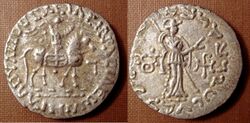Religion:Bajaur reliquary inscription
From HandWiki
Location of the discovery of the find of the Bajaur reliquary, Bajaur, Pakistan .
The Bajaur reliquary inscription is a Buddhist dedicatory inscription found on a reliquary in Bajaur, Pakistan .
The inscription
The inscription, recently discovered and published by Salomon in 2005 gives a triple dating which allows to clarify the relationship between several eras: it is dated to the 27th regnal year of Vijayamitra, a king of the Indo-Scythian Apraca, the 73rd years of the Azes era, and the 201st year of the Greeks (Yonanas or Ionians), that is, the Yavana era.[1]
- "In the twenty-seventh - 27 - year in the reign of Lord Vijayamitra, the King of the Apraca; in the seventy-third - 73 - year which is called "of Azes", in the two hundred and first - 201 - year of the Yonas (Greeks), on the eighth day of the month of Sravana; on this day was established [this] stupa by Rukhana, the wife of the King of Apraca, [and] by Vijayamitra, the king of Apraca, [and] by Indravarma (Indravasu?), the commander (stratega), [together] with their wives and sons."[2]
The Azes era being generally dated to 57 BCE, this implies that the Yavana era started in 185 BCE. It also means that the Azes era started 128 years after the beginning of the Yavana era.
See also
- Yavana era
- Yavanarajya inscription
- Bajaur casket
References



